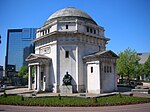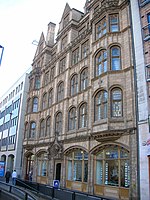V Building
The V Building (formerly known as Arena Central Tower) was a proposed 51-storey residential skyscraper approved for construction on Broad Street on the Westside of the city centre of Birmingham, England. The tower was part of the larger Arena Central development scheme on the former ATV / Central Television Studios, closed in 1997. The entire development site covered an area of 7.6 acres (31,000 m2). On completion the development was set to include offices, shops, restaurants, cafes, leisure/entertainment, fitness centre and hotel. It was to have been built on the site of a multi-level underground car park next to Alpha Tower, one of the tallest buildings in Birmingham. The total cost of the entire scheme was expected to be £400 million and of the tower, £150 million. The estimated completion date was initially set for 2009, but due to setbacks was extended to 2013. In 2009, the developers received a 5-year extension to planning permission; the council turned down a 10-year extension in the hope that work would begin before 2015.The proposed scheme was cancelled during 2014 and alternative plans, which do not include a tall tower, were approved by Birmingham City Council.
Excerpt from the Wikipedia article V Building (License: CC BY-SA 3.0, Authors).V Building
Holliday Street, Birmingham Ladywood
Geographical coordinates (GPS) Address Nearby Places Show on map
Geographical coordinates (GPS)
| Latitude | Longitude |
|---|---|
| N 52.478030555556 ° | E -1.9058083333333 ° |
Address
Holliday Street
B1 1HH Birmingham, Ladywood
England, United Kingdom
Open on Google Maps











